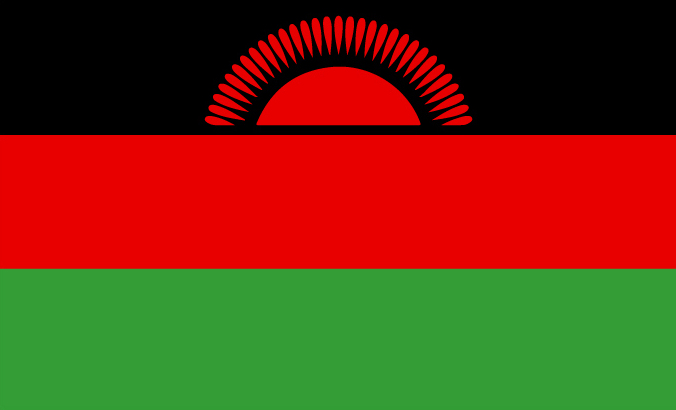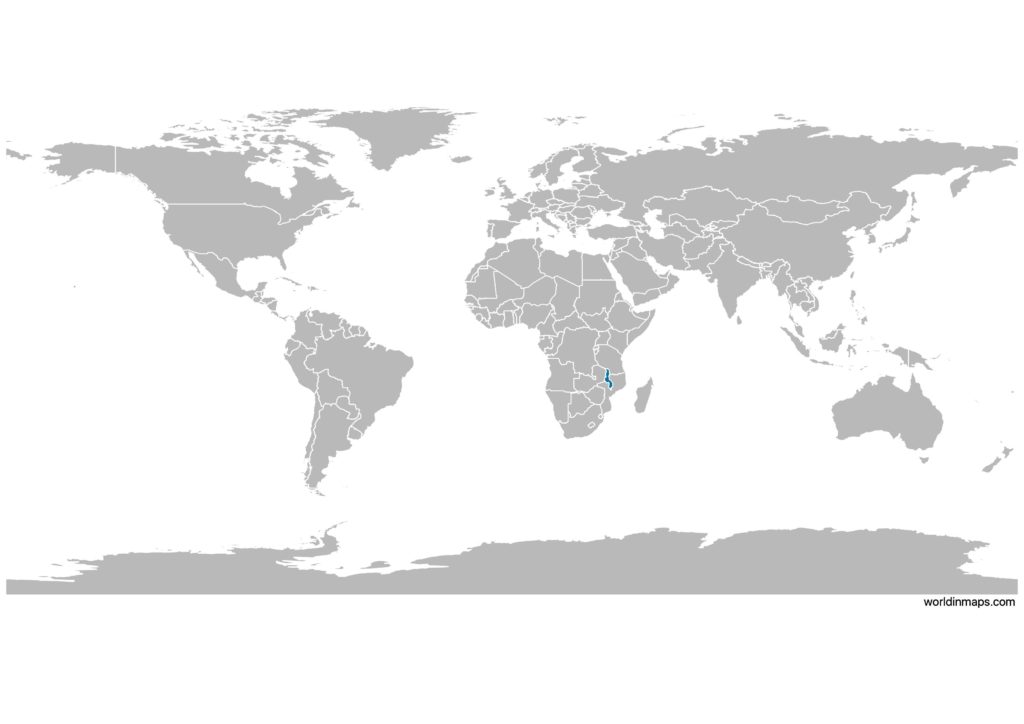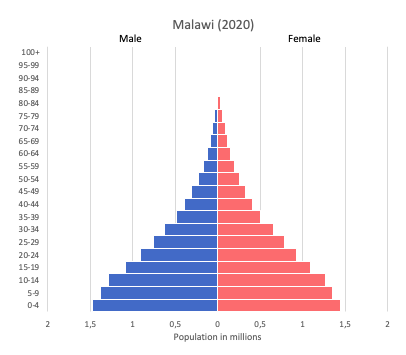Malawi

| Government | |
| Name | Republic of Malawi |
| Chichewa | Dziko la Malaŵi |
| Chitumbuka | Charu cha Malaŵi |
| Government type | presidential republic |
| Capital | Lilongwe (989,318 (2018)) |
| Currency | Kwacha (MWK) |
| Organization | |
| Member State | Commonwealth of Nations |
| People | |
| Population (2020) | 19,129,955 (62nd) |
| Density of population | 153.1 P/km2 (56th) |
| Nationality | Malawian |
| Official languages | |
| English | |
| Ethnic groups (2018) | |
| Chewa | 34.3% |
| Lomwe | 18.8% |
| Yao | 13.2% |
| Ngoni | 10.4% |
| Tumbuka | 9.2% |
| Sena | 3.8% |
| Mang’anja | 3.2% |
| Tonga | 1.8% |
| Nyanja | 1.8% |
| Nkhonde | 1% |
| other | 2.2% |
| foreign | .3% |
| Religions (2009) | |
| Protestant | 33.5% |
| Church of Central Africa Presbyterian | 14.2% |
| Seventh Day Adventist / Baptist | 9.4% |
| Pentecostal | 7.6% |
| Anglican | 2.3% |
| Roman Catholic | 17.2% |
| other Christian | 26.6% |
| Muslim | 13.8% |
| traditionalist | 1.1% |
| other | 5.6% |
| none | 2.1% |
| Life expectancy (2020) | |
| Male | 61.2 years |
| Female | 65.3 years |
| Total population | 63.2 years (205th) |
| Homicides | |
| Total (2012) | 1.8 per 100,000 people (110th) |
| Geography | |
| Land area | 94,080 km2 |
| water area | 24,404 km2 |
| total area | 118,484 km2 (101st) |
| Mean elevation | 779 m |
| Lowest point | |
| junction of the Shire River and international boundary with Mozambique | 37 m |
| Highest point | |
| Sapitwa (Mount Mlanje) | 3,002 m |
| Land use (2011) | |
| Agricultural land | 59.2% |
| Arable land | 38.2% |
| Permanent crops | 1.4% |
| Permanent pasture | 19.6% |
| Forest | 34% |
| Other | 6.8% |
| Urbanization | |
| Urban population (2020) | 17.4% |
| Rate of urbanization | 4.19% annual rate of change (2015 – 2020) |
| Economy | |
| Labor force (2013) | 7 million (66th) |
| Labor force by occupation (2013) | |
| Agriculture | 76.9% |
| Industry | 4.1% |
| Services | 19% |
| Unemployment rate (2013) | 20.4% (187th) |
| GDP (PPP) (estimate 2019) | |
| Total | $25.037 billion |
| Per capita | $1,234 |
| GDP (nominal) (estimate 2019) | |
| Total | $7.436 billion |
| Per capita | $367 |
| GDP by sector (estimate 2017) | |
| Agriculture | 28.6% |
| Industry | 15.4% |
| Services | 56% |
| Exports (2017) | $1.42 billion (150th) |
| Exports partners (2017) | |
| Zimbabwe | 13.1% |
| Mozambique | 11.8% |
| Belgium | 10.7% |
| South Africa | 6.3% |
| Netherlands | 5% |
| UK | 4.7% |
| Germany | 4.3% |
| US | 4.2% |
| Imports (2017) | $2.312 billion (161st) |
| Imports partners (2017) | |
| South Africa | 20.7% |
| China | 14.2% |
| India | 11.6% |
| UAE | 7% |
| Netherlands | 4.4% |
Malawi on the world map

Malawi top 10 largest cities (2018)
- Lilongwe (989,318)
- Blantyre (800,264)
- Mzuzu (221,272)
- Zomba (105,013)
- Karonga (61,609)
- Kasungu (58,653)
- Mangochi (53,498)
- Salima (36,789)
- Liwonde (36,421)
- Balaka (36,308)
Demography
Population pyramid

Age structure data
Estimate for 2020:
- 0-14 years: 45.87% (male 4,843,107/female 4,878,983)
- 15-24 years: 20.51% (male 2,151,417/female 2,195,939)
- 25-54 years: 27.96% (male 2,944,936/female 2,982,195)
- 55-64 years: 2.98% (male 303,803/female 328,092)
- 65 years and over: 2.68% (male 249,219/female 318,938)
Remark: the age structure of a population affects a nation’s key socioeconomic issues. Countries with young populations (high percentage under age 15) need to invest more in schools, while countries with older populations (high percentage ages 65 and over) need to invest more in the health sector. The age structure can also be used to help predict potential political issues. For example, the rapid growth of a young adult population unable to find employment can lead to unrest.
Population from 1950 to 2020
Source: United Nations, Department of Economic and Social Affairs, Population Division (2019). World Population Prospects 2019, Online Edition. Rev. 1.
Evolution of the life expectancy from 1960 to 2018
Source: World Development Indicators, The World Bank
Economy
Agriculture:
tobacco, sugarcane, tea, corn, potatoes, sweet potatoes, cassava (manioc, tapioca), sorghum, pulses, cotton, groundnuts, macadamia nuts, coffee, cattle, goats
Industries:
tobacco, tea, sugar, sawmill products, cement, consumer goods
Exports – commodities (2015):
tobacco (55%), dried legumes (8.8%), sugar (6.7%), tea (5.7%), cotton (2%), peanuts, coffee, soy
Imports – commodities:
food, petroleum products, semi-manufactures, consumer goods, transportation equipment
Time zone and current time in Malawi
Go to our interactive map to get the current time in Malawi